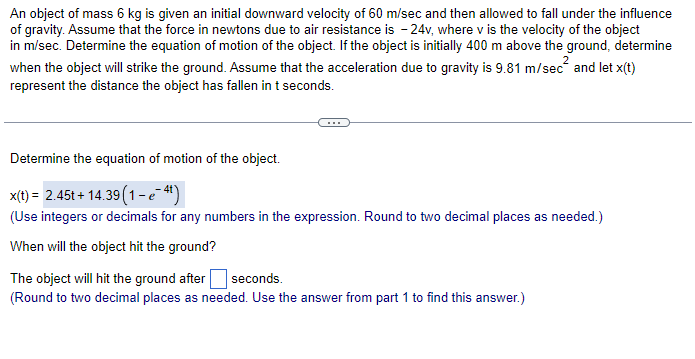of gravity. Assume that the force in newtons due to air resistance is -24v, where v is the velocity of the object in m/sec. Determine the equation of motion of the object. If the object is initially 400 m above the ground, determin 2 when the object will strike the ground. Assume that the acceleration due to gravity is 9.81 m/sec² and let x(t) represent the distance the object has fallen in t seconds. Determine the equation of motion of the object. x(t) = 2.45t+14.39 (1-e-4¹) (Use integers or decimals for any numbers in the expression. Round to two decimal places as needed.) When will the object hit the ground? The object will hit the ground after seconds. (Round to two decimal places as needed. Use the answer from part 1 to find this answer.)
of gravity. Assume that the force in newtons due to air resistance is -24v, where v is the velocity of the object in m/sec. Determine the equation of motion of the object. If the object is initially 400 m above the ground, determin 2 when the object will strike the ground. Assume that the acceleration due to gravity is 9.81 m/sec² and let x(t) represent the distance the object has fallen in t seconds. Determine the equation of motion of the object. x(t) = 2.45t+14.39 (1-e-4¹) (Use integers or decimals for any numbers in the expression. Round to two decimal places as needed.) When will the object hit the ground? The object will hit the ground after seconds. (Round to two decimal places as needed. Use the answer from part 1 to find this answer.)
Linear Algebra: A Modern Introduction
4th Edition
ISBN:9781285463247
Author:David Poole
Publisher:David Poole
Chapter1: Vectors
Section1.4: Applications
Problem 9EQ
Related questions
Question

Transcribed Image Text:An object of mass 6 kg is given an initial downward velocity of 60 m/sec and then allowed to fall under the influence
of gravity. Assume that the force in newtons due to air resistance is -24v, where v is the velocity of the object
in m/sec. Determine the equation of motion of the object. If the object is initially 400 m above the ground, determine
when the object will strike the ground. Assume that the acceleration due to gravity is 9.81 m/sec and let x(t)
represent the distance the object has fallen in t seconds.
Determine the equation of motion of the object.
x(t) = 2.45t+14.39 (1-e-4¹)
(Use integers or decimals for any numbers in the expression. Round to two decimal places as needed.)
When will the object hit the ground?
The object will hit the ground after seconds.
(Round to two decimal places as needed. Use the answer from part 1 to find this answer.)
Expert Solution
This question has been solved!
Explore an expertly crafted, step-by-step solution for a thorough understanding of key concepts.
Step by step
Solved in 3 steps with 3 images

Recommended textbooks for you

Linear Algebra: A Modern Introduction
Algebra
ISBN:
9781285463247
Author:
David Poole
Publisher:
Cengage Learning

Trigonometry (MindTap Course List)
Trigonometry
ISBN:
9781337278461
Author:
Ron Larson
Publisher:
Cengage Learning

Linear Algebra: A Modern Introduction
Algebra
ISBN:
9781285463247
Author:
David Poole
Publisher:
Cengage Learning

Trigonometry (MindTap Course List)
Trigonometry
ISBN:
9781337278461
Author:
Ron Larson
Publisher:
Cengage Learning